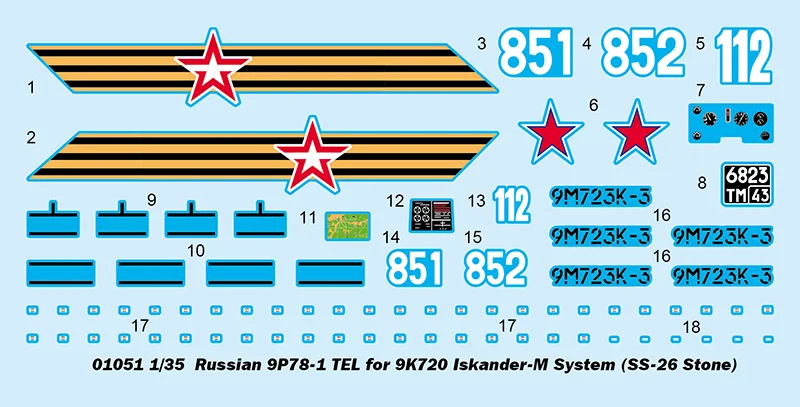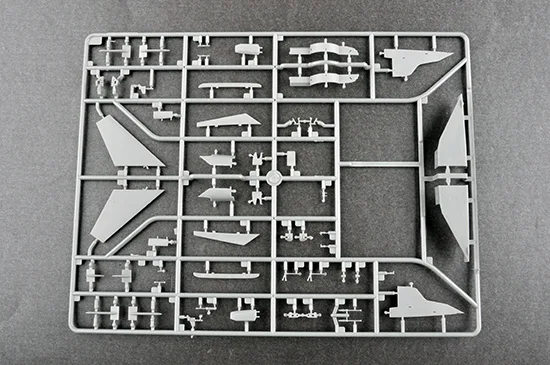We wait every month for Trumpeter to add sprue pictures to their new item previews - they have finally got their fingers out and now we can show you this month's new items with boxart, model profiles and colours and the contents of the kit in our preview.
The Iskander appears to have several different conventional warheads, including a cluster munitions warhead, a fuel-air explosive enhanced-blast warhead, a high explosive-fragmentation warhead, an earth penetrator for bunker busting and an electromagnetic pulse device for anti-radar missions.
The missile can also carry nuclear warheads. The first successful launch occurred in 1996. In 2006, serial production of the Iskander-M Tactical Ballistic Missile System launched, and the system was adopted by the Russian army.
Schleswig-Holstein fought in both World Wars. During World War I, she saw front-line service in II Battle Squadron of the High Seas Fleet, culminating in the Battle of Jutland on 31 May – 1 June 1916. Schleswig-Holstein saw action during the engagement and was hit by one large-calibre shell. After the battle, Schleswig-Holstein was relegated to guard duty in the mouth of the Elbe River before being decommissioned in late 1917. As one of the few battleships permitted for Germany by the terms of the Treaty of Versailles, Schleswig-Holstein was again pressed into fleet service in the 1920s. In 1935, the old battleship was converted into a training ship for naval cadets.
The KH-47M2 missile is the first and only air-based hypersonic air-launched ballistic missile in the world. The appearance is very similar to the appearance of the Russian main military tactical missile "Iskander-M". The fuselage/wing integrated design is adopted. The projectile is cylindrical and has no obvious intake port, and the tail has obvious "ten" shaped small pneumatic tail.
The Missile weighs about 5 tons, with a length of about 7 to 8 meters, a diameter of about 2 meters, and a wingspan of less than 0.5 meters. The head of the missile has a slender double cone streamline shape, and the engine compartment of the central engine shows an obvious crown. The maximum speed is up to Mach 10. At the same time, both the ballistic missile and cruise missile's functional characteristics can carry various high equivalent warheads. It is called "the most difficult missile to intercept in the world".
Trumpeter's Sprues, colours and art for June...
Russian 9P78-1 TEL for 9K720 Iskander-M System (SS-26 Stone)
Model: #01051
1:35th
The 9K720 Iskander ( NATO reporting name SS-26 Stone) is a mobile short-range ballistic missile system produced and deployed by the Russian Federation. The road-mobile Iskander was the second attempt to replace the Scud missile. The first attempt, the Oka, was eliminated under the INF Treaty. The Iskander appears to have several different conventional warheads, including a cluster munitions warhead, a fuel-air explosive enhanced-blast warhead, a high explosive-fragmentation warhead, an earth penetrator for bunker busting and an electromagnetic pulse device for anti-radar missions.
The missile can also carry nuclear warheads. The first successful launch occurred in 1996. In 2006, serial production of the Iskander-M Tactical Ballistic Missile System launched, and the system was adopted by the Russian army.
20 sprues, cab and tires
Photo-Etched Parts Included
copper cable Included
Total Parts 900+
Model Length: 376.5mm Width: 96mm
Full drive train assembly complete with engine transmission, differential housing and suspension units.
The main tires are hollow rubber with a very good tread pattern
The windshield and side windows are made of clear parts.
Schleswig – Holstein Battleship 1908
Model: #05355
1:350th scale
Length: 367.1mm Beam: 67.2mm
Metal anchor chain
Photo-Etched Parts Included
Total Sprues 12 sprues
The kit contains over 470 parts
- The hull is split into two parts
- Deck wood pattern finely rendered
- Contains display stand
SMS Schleswig-Holstein was the last of the five Deutschland-class battleships built by the German Kaiserliche Marine. The ship, named for the province of Schleswig-Holstein, was laid down in the Germaniawerft dockyard in Kiel in August 1905 and commissioned into the fleet nearly three years later. The ships of her class were already outdated by the time they entered service, being inferior in size, armour, firepower and speed to the new generation of dreadnought battleships. Schleswig-Holstein fought in both World Wars. During World War I, she saw front-line service in II Battle Squadron of the High Seas Fleet, culminating in the Battle of Jutland on 31 May – 1 June 1916. Schleswig-Holstein saw action during the engagement and was hit by one large-calibre shell. After the battle, Schleswig-Holstein was relegated to guard duty in the mouth of the Elbe River before being decommissioned in late 1917. As one of the few battleships permitted for Germany by the terms of the Treaty of Versailles, Schleswig-Holstein was again pressed into fleet service in the 1920s. In 1935, the old battleship was converted into a training ship for naval cadets.
Schleswig-Holstein fired the first shots of World War II when she bombarded the Polish base at Danzig's Westerplatte in the early morning hours of 1 September 1939. The ship was used as a training vessel for the majority of the war and was sunk by British bombers in Gotenhafen in December 1944. Schleswig-Holstein was subsequently salvaged and then beached for use by the Soviet Navy as a target. As of 1990, the ship's bell was on display in the Bundeswehr Military History Museum in Dresden.
MiG-31BM. w/KH-47M2 01697
Model:01697
1:72nd scale
Model Length: 314.6mm Wingspan: 186.9mm
10 sprues and fuselage
The kit consists of over 210 parts, clear parts for canopy with finely engraved panel lines
The MiG-31’s ability to deliver heavy payloads at such impressive heights and speeds explains why it is currently the only Russian jet fighter cleared to be serially outfitted with Kinzhal hypersonic missiles. A 12 to 16-unit squadron of Kinzhal-armed MiG-31’s was deployed around the Black Sea region in mid-2018, after several rounds of combat testing in the prior months.The KH-47M2 missile is the first and only air-based hypersonic air-launched ballistic missile in the world. The appearance is very similar to the appearance of the Russian main military tactical missile "Iskander-M". The fuselage/wing integrated design is adopted. The projectile is cylindrical and has no obvious intake port, and the tail has obvious "ten" shaped small pneumatic tail.
The Missile weighs about 5 tons, with a length of about 7 to 8 meters, a diameter of about 2 meters, and a wingspan of less than 0.5 meters. The head of the missile has a slender double cone streamline shape, and the engine compartment of the central engine shows an obvious crown. The maximum speed is up to Mach 10. At the same time, both the ballistic missile and cruise missile's functional characteristics can carry various high equivalent warheads. It is called "the most difficult missile to intercept in the world".
Russian TOS-1 Multiple Rocket Launcher Mod.1989
Model:09560
1:35th scale
TOS-1 is a Soviet 220mm 24-barrel (Ob.634B or TOS-1A) multiple rocket launcher and thermobaric weapon mounted on a T-72 tank chassis. TOS-1 was designed for defeating enemy personnel in fortifications, in open country, and in lightly armoured vehicles and transport. First combat tests took place in 1988-1989 in the Panjshir Valley during the Soviet war in Afghanistan. The TOS-1 was shown for the first time in public in 1999 in Omsk.
Model Length:213.4mm / Width: 101.8mm
Photo-Etched Parts Included
28 sprues and lower hull
The kit consists of over 1000 parts
>multi-slide moulded lower hull
>individual tracks
These new kits should be available from your LHS or Trumpeter's Distributors this month...


























































